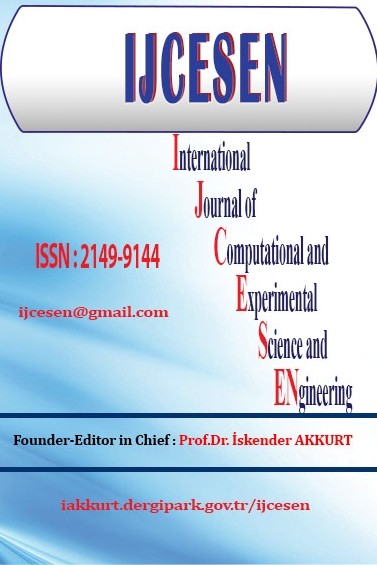Optimization Of Traffic Signalization For Complex Roundabout By Fuzzy Logic According To Various Parameters
Optimization Of Traffic Signalization For Complex Roundabout By Fuzzy Logic According To Various Parameters
Fuzzy logic, Intersection control, Intersection control,
___
- [1] L.A. Zadeh, Inform. Control 8, 338 (1965).
- [2] Pappis, C.P.,Mamdani, E.H., A Fuzzy Logic Controller for a Traffic Junction, IEEE Transactions on systems, Man and Cybernetics, 707-717,(1977).
- [3] Tzes A., McShane and Kim, S., Expert Fuzzy Logic Traffic Signal Control for Transportation Networks, Institute of Transportation Engineers 65th Annual Meeting, Denver USA, 154-158, (1995).
- [4] Kim, Jongwan, A Fuzzy Logic Control Simulator for Adaptive Traffic Management, Proc IEEE International Conference on Fuzzy Systems, 1519-1524, (1997).
- [5] Desai, D., Somani, S., 2014. Instinctive traffic control and vehicle detection techniques. International Journal of Scientific & Engineering Research 5 (1), 2192-2195.
- [6] Hegyi, A., Bellemans, T., De-Schutter, B., 2009. Freeway traffic management and control, In: Meyers, R.A. (Ed.), Encyclopaedia of Complexity and Systems Science. Springer, New York, pp. 3943-3964.
- [7] Kuhne, R.D., 1991. Freeway control using a dynamic traffic flow model and vehicle reidentification techniques. Transportation Research Record 1320, 251-259.
- [8] N.G. Adar∗ , A. Egrisogut Tiryaki and R. Kozan, , Acta Phys. Pol. A 128, B-348(2015)
- [9] F. Meng, X. Chen, 2015. Correlation Coefficients of Hesitant Fuzzy Sets and Their Application Based on Fuzzy Measures, Cognitive Computation, August 2015, Volume 7, Issue 4, pp 445–463.
- [10] F. Chen, L. Wang, B. Jiang, C. Wen, 2015. An Arterial Traffic Signal Control System Based on a Novel Intersections Model and Improved Hill Climbing Algorithm, Cognitive Computation, August 2015, Volume 7, Issue 4, pp 464–476.
- [11] M. Czubenko, Z. Kowalczuk, A. Ordys, 2015. Autonomous Driver Based on an Intelligent System of Decision-Making, Cognitive Computation, October 2015, Volume 7, Issue 5, pp 569–581.
- [12] Şimşir, F., Özkaynak, E., Ekmekçi D., “Kavşaklarda Trafik Sinyalizasyon Sisteminin Modellemesi ve Benzetimi”, Akademik Bilişim, (2013).
- [13] https://www.anl.gov/sites/anl.gov/files/idling_worksheet.pdf(Access Date: 21.08.2017)
- [14] www.cleancities.energy.gov (Access Date: 21.08.2017)
- [15] https://www.afdc.energy.gov(Access Date: 21.08.2017)
- [16] O.M. Pişirir and O. Bingöl, Acta Phys. Pol. A 130, 36 (2016)
- [17] B. Kiriş , O. Bingöl , R. Şenol and A. Altintaş, Acta Phys. Pol. A 130, 55 (2016)
- Yayın Aralığı: 4
- Başlangıç: 2015
- Yayıncı: Prof.Dr. İskender Akkurt
Natural Radiation Measurement in Some Soil Samples from Basra oil field, IRAQ State
Hadi ALBIDHANI, Kadir GUNOGLU, İskender AKKURT
Experimental Comparison of Al5083 Alloy Subjected to Annealing and Equal-Channel Angular Pressing
Mehmet ŞAHBAZ, Hasan KAYA, Aykut KENTLİ, Mehmet UÇAR, Serkan ÖĞÜT, Kerim ÖZBEYAZ
Utilization of Marble and Boron Waste in Brick Products
Atilla EVCİN, Bahri ERSOY, Hakan ÇİFTÇİ
Effect of Change in Radial Clearance on Pressure Variation of Fluid in Hydrodynamic Journal Bearing
Wei ZHAO, Huiqing LIU, Chuan LU, Jing WANG, Lin MENG, Ruihong ZHONG
Determination of The Cross Types to be used in a Trailer Chassis by Finite Element Method
The Key Factor Analysis to the Reservoirs on the Basis of Bayesian Law
Jian SUN, Qi LI, Mingqiang CHEN, Zekai ZHANG
Clustering of European Countries in terms of Healthcare Indicators
